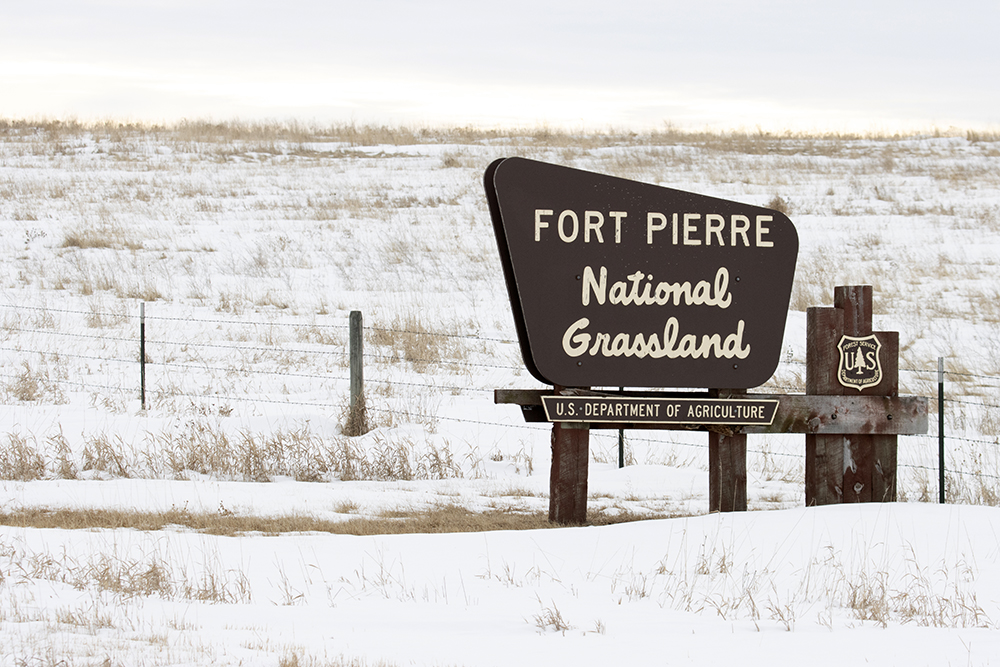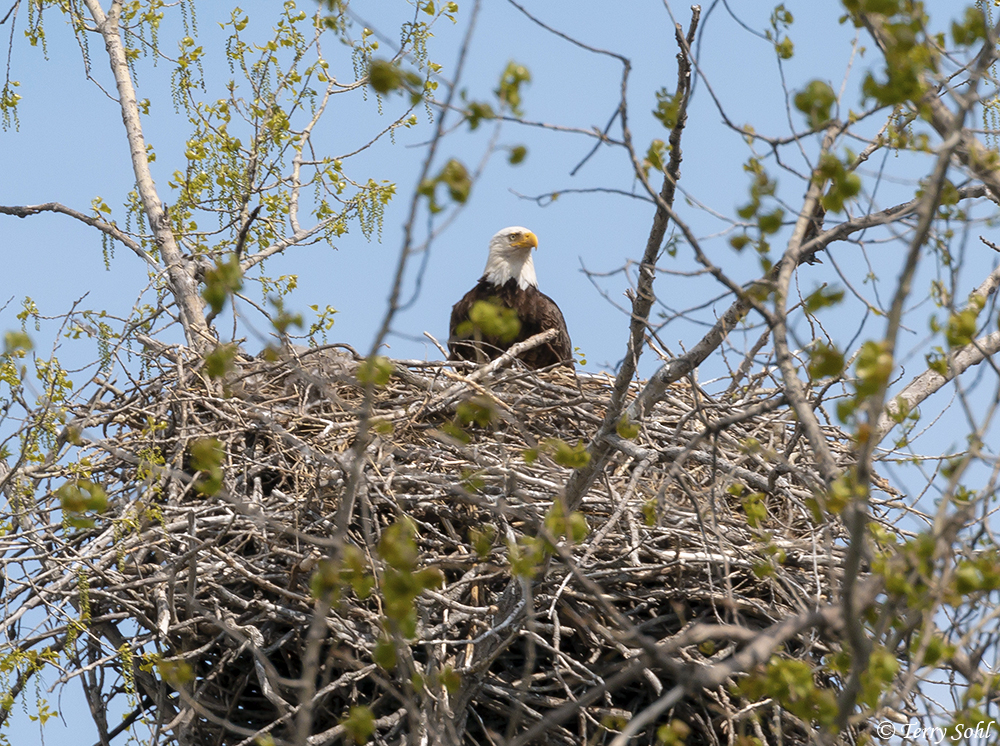
A Bald Eagle in flight, taken just north of Kennebec, South Dakota. I saw over a dozen of these guys today on the grasslands, and area far from any large water body. I’ve found multiple huge eagle nests in the area in recent years, as they’ve obviously learned that with all the pheasants, grouse, and prairie chickens in the area, it’s a GREAT place to raise (and feed!) a family!
Today was “the” day. Once or twice a winter, I’ll get up ridiculously early, drive three hours to the central part of the state to ensure I get there right at dawn, and spend the day birding. What could possess anyone to head to central South Dakota before dawn in the middle of winter?
Winter raptors! As I’ve said many times, central South Dakota can be truly spectacular for raptors during the winter time. That surprises a lot of people. Winters can be pretty damned harsh up here…the blizzard that shut down the western half of the state for the last 2 days is a great example! In eastern South Dakota in winter, near Brandon where I live, if I drive rural areas I’m not likely to see much for bird life. The best I can usually hope for is to run across some flocks of Snow Buntings or Lapland Longspurs, but for the most part, all the crop land in the eastern part of the state is pretty dead in the winter.
It’s dramatically different in the central part of the state. The reason? Better habitat with cropland interspersed with a lot of open grassland, and more importantly, plentiful prey! Ring-necked Pheasants, Sharp-tailed Grouse, and Greater Prairie Chickens are beyond abundant in many parts of central South Dakota, and attract raptors that can take such big prey, including many eagles (Bald and Golden), Ferruginous Hawks, Gyrfalcons, and more. The wide-open grasslands of the region also hold many large flocks of Lapland Longspurs, Horned Larks, and Snow Buntings in the winter, smaller prey that are favorites for Merlins and Prairie Falcons. It doesn’t seem to matter the weather, most of the time when I head out there, there are a lot of fat and happy raptors! That was evident again today, as it was quite obvious (from the full crops on several birds) that the birds were feeding quite well!
There are two general areas I like to bird in the central part of the state: 1) The Presho/Kennebec corridor near I-90, and 2) the Fort Pierre National Grasslands to the north. As with most of my central South Dakota trips, I timed my drive today to arrive at Presho right around dawn. My day of birding usually begins with the area just south of Presho, an area that’s been truly magical for me for winter raptors in recent years. The big attraction for raptors are the game birds in the area. There are a number of hunting operations in the area, many of which release pheasants for hunters. There have been times in the winter where I’ll 100-200 Ring-necked Pheasants milling about in a field, and there are plenty of Sharp-tailed Grouse in the area as well. Today got off to a rocky start as it was uncharacteristically slow in the Presho area. Right upon arriving, I came across a Merlin feeding on a small bird (most likely a Horned Lark), and I did find a couple of Bald Eagles south of Presho, but the Rough-legged Hawks that usually are EVERYWHERE in winter were curiously absent. I spent more time cruising random gravel roads in Presho and Kennebec area this morning and picked up a stray raptor here or there, but it was a depressingly slow start for the day.

A Rough-legged Hawk just after taking flight from a telephone pole. These guys are always the undisputed “kings” of the prairie in winter, at least in terms of sheer numbers. Today’s count of 32 Rough-legged Hawks was actually a bit of a disappointment. I’ve had some winter days where the count has been more than twice that.
Given the lack of action near Presho and Kennebec, I started to drift northward towards the Fort Pierre National Grasslands. It soon became abundantly clear that the blizzard from this weekend took a increasingly greater toll the further you moved north from I-90. Gravel roads are usually somewhat immune to freezing rain, but the amount of freezing rain and slush from this storm was truly amazing, and even gravel roads were smooth, slick mirrors in some spots. It was even worse for birds in the area, though. The grasslands were coated with a thick sheet of ice and slush, and many of the game birds in the area appeared to be struggling. On the Fort Pierre National Grasslands themselves, I came across several huge flocks of Sharp-tailed Grouse and Greater Prairie Chickens, milling about in open grassy areas, searching for clear spots in the ice so they could forage. Despite all the potential prey, however, there were very few raptors on the grasslands themselves. The day wasn’t getting any better.
Something has happened on the Fort Pierre National Grasslands over the last 5 years. 5 years ago, winter raptor birding on the Grasslands was typically spectacular. Scanning the fence posts and telephone poles, it was often unusual if you could drive a mile WITHOUT encountering a raptor. Over the last 5 years though, the grasslands have been curiously devoid of raptors. That again was the case today. As slow as the birding was around Presho in the morning, it was MUCH slower on the Grasslands further north. There are definitely fewer pheasants and grouse on the grasslands than in the area around Presho, but the last 5 years have made me wonder if something has also happened to the small rodent population in the area. It just seems odd that such consistently great birding for many years could nosedive and stay low for so long.
I admit that by noon, I was a little down. An entire day devoted to birding the area, and it was pretty slow to that point. I decided to head back down towards Presho and Kennebec again, and it soon became clear that there were PLENTY of raptors in the area, and that they were much more active than they had been in the morning. Driving the gravel roads just north of Presho and Kennebec, the usually plentiful Rough-legged Hawks, a species that was almost absent during my morning search, were back in force (where had they been this morning?!?). Red-tailed Hawks were present in larger numbers than normal, and I ran into the occasional Prairie Falcon or Ferruginous Hawk as well. One thing that surprises people is how common eagles are in the area in winter, both Bald Eagles and Golden Eagles. There are multiple active Bald Eagle nests in the Presho and Kennebec area, in the middle of the grasslands and far from any large water body, while Golden Eagles that are absent in the area in winter often show up in good numbers for the winter.

A Greater Prairie Chicken, searching for food in a prairie covered by a crust of ice and snow. Despite how common these are in parts of Central South Dakota, they’re actually a species I’ve never had any luck photographing! Not the greatest photo here, but at least I finally have something.
I didn’t run across any of the “special” winter raptors today. To me, the list of “special” winter raptors includes Gyrfalcon, Snowy Owl, and Short-eared Owl. I’d estimate that I spot one of those species in about half of the trips I take to the area, but not today. It was still a beautiful day for birding, and the final raptor count for the day ended up being pretty good. Honestly, the tally here is a little lower than what I’ve normally experienced in the area in recent years, but that just emphasizes how truly spectacular winter birding has been lately! The raptor count for the day:
- Rough-legged Hawks — 32
- Bald Eagle — 13
- Red-tailed Hawks – 12
- Golden Eagles – 5
- Ferruginous Hawks – 4
- Merlin – 4
- Prairie Falcon – 3
While raptors are definitely the attraction for birding the area in winter, there have been some other trends in recent years that are certainly interesting. I started birding 16 years ago, and during those first few winters when I would bird this area, it was always surprising to run across a stray Western Meadowlark here or there. In recent years, it seems like more and more Meadowlarks stay in the area all winter long, and today, I came across literally hundreds and hundreds. I also came across two large flocks of American Robins, a species that does sometimes overwinter in the area in small numbers, but there were probably at least 100 Robins in each flock I saw today. Southeast of Presho, there also have been large numbers of Red-winged Blackbirds that have been overwintering in recent years.
Three different species of birds, each of which is found in ever-increasing numbers in winter over the last several years…hmmm…I wonder what the cause could be? It’s almost as if there’s some kind of “warming” effect that’s enabling them to overwinter. Perhaps someday scientists will discover what’s behind such a change in climate. 🙂
Like this:
Like Loading...











































